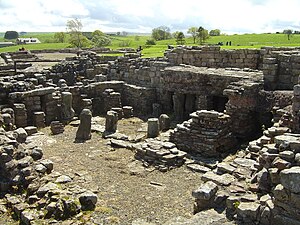Vindolanda
| Vindolanda | |
|---|---|
|
Chesterholm Museum Bardon Mill, Hexham, Northumberland NE47 7JN |
|

Military bathhouse at Vindolanda
|
|
| Coordinates | 54°59′33″N 2°21′11″W / 54.992571°N 2.353193°WCoordinates: 54°59′33″N 2°21′11″W / 54.992571°N 2.353193°W |
| Grid reference | grid reference NY7766 |
| Type | Roman fort |
| Site information | |
| Controlled by | Vindolanda Trust |
| Open to the public |
Yes |
| Condition | Ruined |
| Website | http://www.vindolanda.com/ Created By The Company E-Strands Ltd |
Chesterholm Museum Bardon Mill, Hexham, Northumberland
Vindolanda was a Roman auxiliary fort (castrum) just south of Hadrian's Wall, which it predates, in northern England. Located near the modern village of Bardon Mill, it guarded the Stanegate, the Roman road from the River Tyne to the Solway Firth. It is noted for the Vindolanda tablets, among the most important finds of military and private correspondence (written on wooden tablets) found anywhere in the Roman Empire.
The first post-Roman record of the ruins at Vindolanda was made by the antiquarian William Camden, in his Britannia (1586). Occasional travellers reached the site over the next two hundred years, and the accounts they left are useful because they predate much of the stone-stealing that has damaged the site. The military bath-house was still partly roofed when Christopher Hunter visited the site in 1702. In about 1715 an excise officer named John Warburton found an altar there, which he removed. In 1814 the first real archaeological work was begun, by the Rev. Anthony Hedley. Hedley died in 1835, before writing up his discoveries. Little more was done for a long time, although in 1914 a workman found another altar at the site, set up by the civilians living at the fort in honour of the Divine House and Vulcan. Several names for the site are used in the early records, including Chesters on Caudley, Little Chesters, the Bower, and Chesterholm; the altar found in 1914 confirmed that the true Roman name for the site was "Vindolanda", which had been in dispute as one early source referred to it as "Vindolana".
The garrison were auxiliary infantry or cavalry units, not components of Roman legions. From the early third century AD onwards, this was the Fourth Cohort of Gauls. It had been presumed that this title was by this time purely nominal, with auxiliary troops being recruited locally, but an inscription found in a recent season of excavations suggests that native Gauls were still to be found in the regiment and that they liked to distinguish themselves from British soldiers. The inscription reads:
...
Wikipedia

